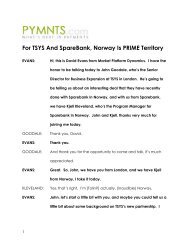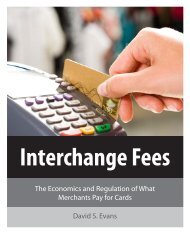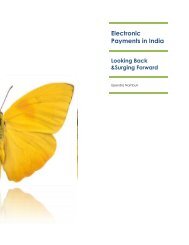Lydian Payments Journal - PYMNTS.com
Lydian Payments Journal - PYMNTS.com
Lydian Payments Journal - PYMNTS.com
You also want an ePaper? Increase the reach of your titles
YUMPU automatically turns print PDFs into web optimized ePapers that Google loves.
elationship with an acquirer, it is able to accept payment card transactions. The merchant either pays a<br />
fixed per transaction fee (more <strong>com</strong>mon for debit cards) or a proportion of the total purchase amount,<br />
known as the merchant discount fee (more <strong>com</strong>mon for credit cards), to its acquirer. In some instances,<br />
merchants are charged a fixed fee and a proportional fee. For credit cards, the merchant discount can range<br />
from 1% to 5% depending on the type of transaction, type of merchant, and type of card, as well as whether<br />
the card is present or not, among other factors. Fourth, the acquirer pays an interchange fee to the issuer.<br />
Studying the costs to banks to provide payment services is difficult, given the proprietary nature of the cost<br />
data. However, there are some European studies that attempt to quantify the real resource costs of several<br />
payment services. In these studies, social cost refers to the total cost for society net any monetary transfers<br />
between participants, and reflects the real use of resources used in the production and usage of payment<br />
services. For the Netherlands in 2002, Brits and Winder report that the social costs of all point‐of‐sale<br />
(POS) payments (cash, debit cards, credit cards, and prepaid cards) amounted to 0.65% of gross domestic<br />
product (GDP). 6 The social cost of payment services for Belgium in 2003 was 0.75% of GDP. 7 Bergman,<br />
Guibourg, and Segendorff find that the social cost of providing cash, debit card payments, and credit card<br />
payments was approximately 0.4% of GDP in Sweden for 2002. 8 Based on a panel of 12 European countries<br />
during the period 1987–99, Humphrey et al. conclude that a <strong>com</strong>plete switch from paper‐based payments<br />
to electronic payments could generate a total cost benefit close to 1% of the 12 nations’ (Belgium,<br />
Denmark, Finland, France, Germany, Italy, the Netherlands, Norway, Spain, Sweden, Switzerland, and the<br />
United Kingdom) aggregate GDP. 9<br />
These numbers confirm the widespread agreement that the ongoing shift from paper‐based payments to<br />
electronic payments may result in large economic gains. Compared with cash, electronic payments also<br />
offer benefits in terms of greater security, faster transactions, and better recordkeeping; in addition,<br />
electronic payments offer possible access to credit lines. Some key benefits of using cash include privacy<br />
and anonymity that payment cards do not provide. Merchants may also benefit from increased sales or cost<br />
6 Hans Brits and Carlo Winder, “<strong>Payments</strong> Are No Free Lunch,” Occasional Studies, De Nederlandsche Bank 3(2)<br />
(2005).<br />
7 Guy Quaden, “Costs, Advantages, and Disadvantages of Different Payment Methods,” (report presented for the<br />
National Bank of Belgium, December 2005).<br />
8 Mats Bergman, Gabriela Guibourg, and Björn Segendorff, “The Costs of Paying—Private and Social Costs of Cash and<br />
Card,” working paper No. 212, Sveriges Riksbank, 2007.<br />
9 David Humphrey et al., “Benefits From a Changing Payment Technology in European Banking,” <strong>Journal</strong> of Banking<br />
and Finance 30(6): 1631–1652 (June 2006).<br />
© 2009. Copying, reprinting, or distributing this article is forbidden by anyone other than the publisher or author. 15








